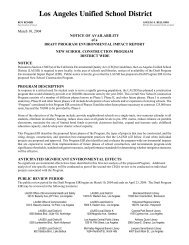Site-Specific Health and Safety Plan (HASP) - Laschools.org
Site-Specific Health and Safety Plan (HASP) - Laschools.org
Site-Specific Health and Safety Plan (HASP) - Laschools.org
Create successful ePaper yourself
Turn your PDF publications into a flip-book with our unique Google optimized e-Paper software.
LAUSD Proposed South Region High School #9 & Middle School #4<br />
11-1<br />
December 2006<br />
<strong>Site</strong> <strong>Specific</strong> <strong>Health</strong> & <strong>Safety</strong> <strong>Plan</strong> (<strong>HASP</strong>)<br />
11.0 FREQUENCY AND TYPES OF AIR MONITORING<br />
Air monitoring will be used to identify <strong>and</strong> quantify airborne levels of hazardous substances.<br />
Periodic monitoring is required during on-site activities. During work in contaminated areas,<br />
continuous monitoring will be required. The type of monitoring <strong>and</strong> equipment to be used is as<br />
follows:<br />
11.1 AIR MONITORING<br />
At this <strong>Site</strong>, measures will be taken to minimize personnel exposure <strong>and</strong> to implement protective<br />
actions. Direct reading instruments may be used to rapidly detect flammable or explosive<br />
atmospheres <strong>and</strong> certain gases <strong>and</strong> <strong>org</strong>anic vapors. Direct reading instruments provide<br />
information at the time of sampling, thus enabling rapid decision-making. Gases <strong>and</strong> <strong>org</strong>anic<br />
vapors will be monitored in the breathing zone <strong>and</strong> work area to determine the level of protection<br />
required. Integrated personal monitoring (8-hour TWA) with subsequent laboratory analysis<br />
may be warranted by site-specific conditions <strong>and</strong> is required by regulation to make an initial<br />
determination of potential airborne exposures.<br />
Metals, PAHs, <strong>and</strong> PCBs are not generally expected to present an inhalation hazard unless they<br />
are present in a particulate form or contained in dust generated during field activities. <strong>Site</strong><br />
personnel will implement dust control measures at all times to prevent fugitive dust emissions<br />
<strong>and</strong> exposures to dust. Dust control measures may consist of watering the site, wetting<br />
construuction equipment (eg, buckets) lowering site speed limits, or using dust suppressants to<br />
keep the soil moist/wet. Previous air monitoring results have shown that metals (i.e. lead) are<br />
not a major inhalation hazard unless the metal is in the form of a fume, provided dust control<br />
measures are implemented. However, in areas where significant levels of metals, PAHs, or<br />
PCBs are suspected, air samples will be collected <strong>and</strong> analyzed using appropriate NIOSH or<br />
OSHA analytical methods.<br />
During site activities, air monitoring will be used to identify <strong>and</strong> quantify airborne levels of<br />
hazardous substances. Continuous monitoring is required during on-site activities. The types of<br />
monitoring <strong>and</strong> equipment to be used are identified in Table 11−1.<br />
11.2 TYPES AND FREQUENCY OF AIR MONITORING<br />
Prior to initiating a field task, the PM, Project <strong>Health</strong> <strong>and</strong> <strong>Safety</strong> Manager, <strong>and</strong> SHSO will<br />
determine the type <strong>and</strong> frequency of air monitoring necessary for the scheduled work.<br />
During field investigation activities, as shown in Table 11−1, the following instruments will be<br />
available to conduct air monitoring as appropriate:<br />
• PID instrument, either a Photovac MicroTIP ® or a MiniRae, or an equivalent instrument<br />
to monitor for <strong>org</strong>anic vapors (lamp with ionization potential [IP] of 10.6 electronvolt<br />
[eV], unless the site is impacted with 1,1,1 trichloroethane [TCA] <strong>and</strong>/or other<br />
compounds with IP over 10.6 eV. If the site is impacted with 1,1,1 TCA or any other<br />
compounds with IP over 10.6 eV, a PID equipped with an 11.7 eV lamp will be used).<br />
• Combustible gas indicator (multi-gas detector instrument) to measure the concentration<br />
of combustible gases or vapors, <strong>and</strong> also toxic gasses such as hydrogen sulfide (H2S).<br />
• Benzene <strong>and</strong> other COC colorimetric detector tubes, or chemical specific instruments.<br />
• Personal sampling pumps with appropriate filters <strong>and</strong>/or sorbent media.<br />
• Summa canisters<br />
234







